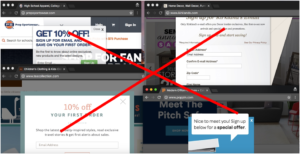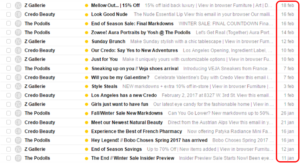Today, every customer needs a custom interaction to encourage buying a product online. But with marketers painting broad strokes over their audiences, the art of personalized communication, and with it, respect has been lost. Businesses don’t take the time respect to their customers in an attempt to increase profit, and it hurts them in the long run.
After 6 years in ecommerce marketing and watching over 1 billion transactions happen across Europe, I’ve noticed the different marketing style. Geographics come into play heavily with marketing tools and communication with customers.
We’ve tracked down the top ways e-commerce stores in the USA are disrespecting their customers during each stage of communication, and are sharing why these methods don’t work and what should be done to change it.
Communication Steps and Basic Store Mistakes
Here’s the communication stages between stores and visitors.

Each of these stages marketers have major issues with.
Get Visitor’s Contact Information
Pop ups, widgets and forms are all relatively simple ways to get visitor’s information. But most ecommerce stores don’t know any better but to serve, ill-equipped tools.
The most common mistakes using contact forms and pop-ups are:
Welcome Popups With A Discount
Most ecommerce stores in the states use welcome pop ups that offer a discount in exchange for the visitor’s info. If you think about the varying degrees of intent to purchase, the problem with this tool is clear.
Approximately .1% – 3% cold visitors fill out welcome pop-ups. Ad fatigue aside, not many visitors feel “welcomed” by a popup right in their face as they enter a site. How many times do you X off of the welcome pop up, only to realize later on the site, that you want to purchase something, and can’t find that discount again.
It’s a matter of timing. Flashing something in a visitors space when they walk into your store doesn’t work in the physical world, and it doesn’t work online either.
For warm visitors who are browsing with an intent to purchase already, the welcome popup is just giving away profit to someone who was already going to make a purchase. This pop up is ineffective, and almost everyone’s doing it.

What is that discount popup came after the visitor showed intent to buy but retracted? Much higher conversions happen.
Pop ups That Don’t Collect Visitor Information
Unlike in the past, popups are now an accepted tool for visitor interaction. Even still, some websites only use the registration form to collect visitor information. In many cases, the registration only happens when a visitor buys something.
Using other tools on the website to collect customer data (widgets, popups, etc.) can increase data collection by 400% – 500%. But email collection alone isn’t enough to convert visitors into sales. Data driven marketing is the key, and almost everyone is missing it.
Lack of tracking, understanding and recording of visitor activity
When a form collects data it doesn’t consider the users activity on the site before they hit the form. This constricts the store from customizing offers and marketing for the customer. It’s disrespectful. In “advanced” tools, they might give the amount of time the user was idle, but this isn’t enough data to do much with.
In fact, studies show that idle popups demotivate the user from converting and welcome discount popups don’t do anything but lower the stores margins.
If the idea behind a idle popup is the catch the user when he’s distracted and alert him into buying something, then why not try and get his attention when he’s about to end the browsing session. The ability to know that the user is about to leave the site is valuable, giving them the right CTA at that time, means more conversions.
I know what you’re thinking…exit popup. But these are missed in a big way too. Many exit popups don’t let someone leave the site until they refuse an offer. How disrespectful. What about asking them if they forgot anything, and then sending them a nice follow up email with exactly the items they looked at on the site.
The biggest mistake by ecommerce stores, not understanding (or not caring) why the visitor didn’t make a purchase. This can only happen through data tracking and respectful communication.
In our practical experience: more than 70% unique visitors fill in a widget when it’s used properly.
Pre-sale email communication
Visitor Site Activity and Intention
Most stores don’t track visitor activity, the items they’re interested in, time spent since last visit and a bunch of other important factors. You wouldn’t believe (30% more) how much sales and revenue can increase when you acknowledge the visitor and show appreciation for their time…and yes, remind them of the items they didn’t purchase. This approach is so successful, it’s surprising that mainstream marketers get away with sending templated messages to their entire lists.
The “Big Data Mistake”
More interesting than visitor profiles, big data can show you what they’re interested in, and motivate them to make a purchase. But most marketing platforms don’t analyze data the way that tells you what the visitor’s habits are and what they’re interested in. This is changing with analytics technologies.
Repeating The Same CTA Over and Over
Unbelievable but true: every third (if not every second) online shop in the United States with a delay of a few days sends more or less the same standard offer Usually it is a chain of emails offering a discount, or news about the store updates. But they are rarely customized to the customer. Why do I need an update about your new vacuum cleaners if I purchased a refrigerator from you? I don’t.
Even worse, sometime there is no motivation at all.
Constant annoyance
There is no need to send a visitor more than one email each week (and sometimes even three weeks), especially if the e-mails have more or less the same content.
Statistics shows, recipients generally start moving your emails to the trash after the third email with irrelevant content.

Only through understanding of real needs of your customers can you show them respect – and it will be not only highly appreciated by your clients but increase your margin. As platforms update, data evolves into tracked ways stores can communicate better with their customers. This is why we started our platform.

Sergey Sitnikov
Sergey is the co-founder and CEO of LeadHit, an ecommerce marketing platform. He’s tracked over $1 Billion Dollars in sales through the platform and has helped ecommerce stores all over the world increase sales through respectful marketing practices.

